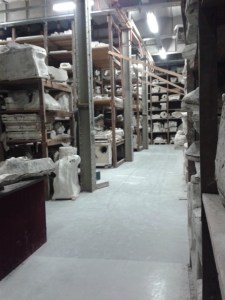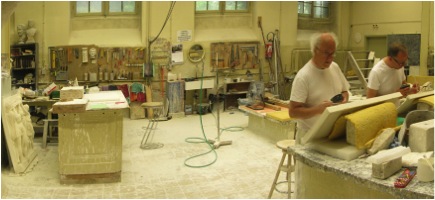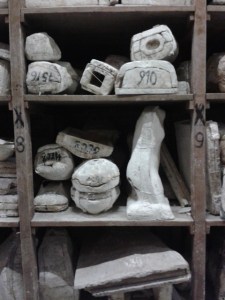To visit the Atelier de Moulage, Brussels’ Plaster Cast Workshop, is to glimpse behind the scenes. Hidden behind the grander facades of Brussels’ Cinquantenaire Museums, the museum storeroom and artist’s workshop was established in the 19th century under King Leopold II when the fashion for displaying plaster casts of Greek and Roman sculpture in private houses, museums, and academies was at its height in Europe. These casts provided teaching tools and substituted classical marbles in Italian collections. The Atelier houses an archive of more than 4,000 casts and moulds of works from prehistory to the 18th century, and continues to produce new ones.

Author’s photograph
In the warehouse, rows of shelves are piled high with moulds. Like strange sarcophagi, these are the negative impressions of the heads and bodies of iconic works of sculpture that are used to make plaster reproductions in the workshop next door. You are free to explore the warehouse unaccompanied, which provides an intriguing model for the open storage galleries that Crystal Bennes has recently argued in favour of on this blog (Apollo 13 June 2014). Exploring the hushed stacks is an exercise in art historical guess-who as you try to match mould to antique sculpture: there are no labels, which encourages you to look hard at the abstract shapes of the moulds, and engage with them as objects on their own terms.
The Atelier’s small museum displays finished casts of famous works of western art, primarily Greek and Roman antiquities. These are precise copies that allow the unusual opportunity to get up close and personal with sculptures usually roped off. Museum spaces such as this gather together works from across the Greek and Roman world which are otherwise dispersed across international collections. Rarely do galleries of original ancient art allow for as comprehensive an overview in as informal a setting.
Of course, a cast cannot completely replace an ancient sculpture; it will always be a version of that artwork, in some eyes a worthless copy. But it is precisely because they are copies that what is lost in terms of ‘authenticity’ is counterbalanced by the opportunity to re-think classical sculpture and ideas of originality vs. replication.

The workshop. Author’s photograph
Although employed in the reproduction of one particular artwork, the moulds in the Atelier represent a series of moments of original creation, a potentially endless plaster-cast chain of contact between positive and negative impressions that ultimately leads back to the original sculpture, but that also results in distinct versions of that original. Each cast is hand-finished in the studio, suggesting how the hand of the artist might affect a finished piece.
We might also wonder how the change in medium, from marble or bronze to plaster, alters how we feel about that sculpture. A cast might even be painted, reproducing an aspect of classical sculpture that is often lost to us today. Viewed this way, can a cast perhaps be more authentic than its model?

Author’s photograph
We tend to think of classical works as unique, but even in antiquity, famous statues were reproduced in different media, including plaster, and displayed variously in contexts. And today, even an ‘original’ Greek or Roman sculpture, lifted from its original context and exhibited in a museum, is not the same sculpture and can never have the same meaning. Casts make more acute this process of removal and reinterpretation that every act of re-display and looking entails, allowing us to see classical sculpture with fresh eyes.
The studio at the Atelier also provides a rare opportunity to re-view classical sculpture as made art, as the direct product of an artist’s hand. Too often, our primary site of engagement with classical art is in a museum, where display cabinets and ropes distance the sculpture, transforming it into something unattainable and esoteric, the perfection and preciousness of which precludes production by ordinary hands. Seeing an artist in the process of making a cast – and talking to him about that process – reminds us that the ancient sculpture is also a manufactured thing, a touched object worked and shaped by the hand. More than just copies, therefore, plaster casts can help re-present classical art by inviting active engagement in a way seldom afforded elsewhere.
The Atelier de Moulage is open Tuesdays to Fridays in Brussels.
Related Articles
Open the stores: conservation, collections and the museum of the future (Crystal Bennes)
Preservation vs Presentation: is digital display a solution for museums? (Katy Barrett)
‘Deliberate Clichés’: An Interview with Matthew Darbyshire (James Cahill)

More than just copies: Brussels’ Plaster Cast Workshop
atelier_012 © RMAH, Brussels
Share
To visit the Atelier de Moulage, Brussels’ Plaster Cast Workshop, is to glimpse behind the scenes. Hidden behind the grander facades of Brussels’ Cinquantenaire Museums, the museum storeroom and artist’s workshop was established in the 19th century under King Leopold II when the fashion for displaying plaster casts of Greek and Roman sculpture in private houses, museums, and academies was at its height in Europe. These casts provided teaching tools and substituted classical marbles in Italian collections. The Atelier houses an archive of more than 4,000 casts and moulds of works from prehistory to the 18th century, and continues to produce new ones.
Author’s photograph
In the warehouse, rows of shelves are piled high with moulds. Like strange sarcophagi, these are the negative impressions of the heads and bodies of iconic works of sculpture that are used to make plaster reproductions in the workshop next door. You are free to explore the warehouse unaccompanied, which provides an intriguing model for the open storage galleries that Crystal Bennes has recently argued in favour of on this blog (Apollo 13 June 2014). Exploring the hushed stacks is an exercise in art historical guess-who as you try to match mould to antique sculpture: there are no labels, which encourages you to look hard at the abstract shapes of the moulds, and engage with them as objects on their own terms.
The Atelier’s small museum displays finished casts of famous works of western art, primarily Greek and Roman antiquities. These are precise copies that allow the unusual opportunity to get up close and personal with sculptures usually roped off. Museum spaces such as this gather together works from across the Greek and Roman world which are otherwise dispersed across international collections. Rarely do galleries of original ancient art allow for as comprehensive an overview in as informal a setting.
Of course, a cast cannot completely replace an ancient sculpture; it will always be a version of that artwork, in some eyes a worthless copy. But it is precisely because they are copies that what is lost in terms of ‘authenticity’ is counterbalanced by the opportunity to re-think classical sculpture and ideas of originality vs. replication.
The workshop. Author’s photograph
Although employed in the reproduction of one particular artwork, the moulds in the Atelier represent a series of moments of original creation, a potentially endless plaster-cast chain of contact between positive and negative impressions that ultimately leads back to the original sculpture, but that also results in distinct versions of that original. Each cast is hand-finished in the studio, suggesting how the hand of the artist might affect a finished piece.
We might also wonder how the change in medium, from marble or bronze to plaster, alters how we feel about that sculpture. A cast might even be painted, reproducing an aspect of classical sculpture that is often lost to us today. Viewed this way, can a cast perhaps be more authentic than its model?
Author’s photograph
We tend to think of classical works as unique, but even in antiquity, famous statues were reproduced in different media, including plaster, and displayed variously in contexts. And today, even an ‘original’ Greek or Roman sculpture, lifted from its original context and exhibited in a museum, is not the same sculpture and can never have the same meaning. Casts make more acute this process of removal and reinterpretation that every act of re-display and looking entails, allowing us to see classical sculpture with fresh eyes.
The studio at the Atelier also provides a rare opportunity to re-view classical sculpture as made art, as the direct product of an artist’s hand. Too often, our primary site of engagement with classical art is in a museum, where display cabinets and ropes distance the sculpture, transforming it into something unattainable and esoteric, the perfection and preciousness of which precludes production by ordinary hands. Seeing an artist in the process of making a cast – and talking to him about that process – reminds us that the ancient sculpture is also a manufactured thing, a touched object worked and shaped by the hand. More than just copies, therefore, plaster casts can help re-present classical art by inviting active engagement in a way seldom afforded elsewhere.
The Atelier de Moulage is open Tuesdays to Fridays in Brussels.
Related Articles
Open the stores: conservation, collections and the museum of the future (Crystal Bennes)
Preservation vs Presentation: is digital display a solution for museums? (Katy Barrett)
‘Deliberate Clichés’: An Interview with Matthew Darbyshire (James Cahill)
Unlimited access from just $16 every 3 months
Subscribe to get unlimited and exclusive access to the top art stories, interviews and exhibition reviews.
Share
Recommended for you
Baron Lorne Thyssen-Bornemisza de Kászon: April Apollo
Baron Lorne Thyssen-Bornemisza speaks to Susan Moore about the opening of Kallos Gallery in London and his love of antiquities
Apollo Awards: Acquisition of the Year
The Apollo Awards shortlist of the most noteworthy acquisitions this year
The Met’s new pavement
If you had $65 million to blow on your local museum, how would you spend it?